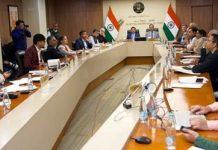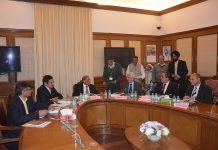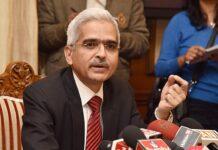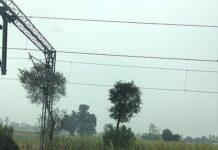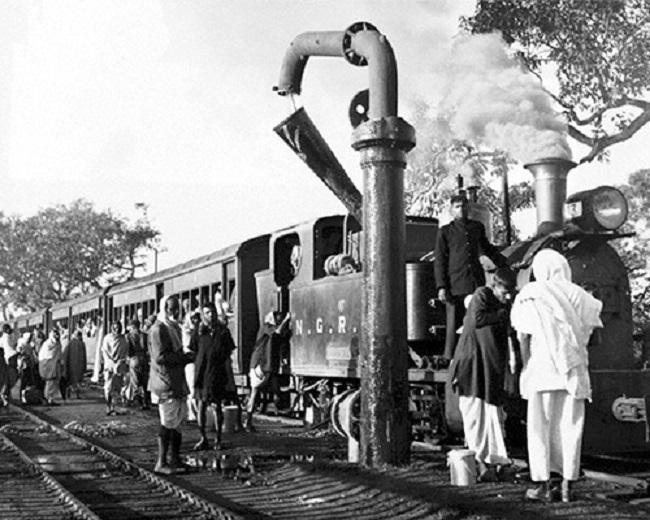
Economic self-reliance is the mantra. What Nepal needs is to build domestic railway network and other physical infrastructures, provide stimulus and protection to domestic industries against competition from cheap imports. BRI/CPEC has already destroyed thriving domestic industries and made Pakistan a market (aka colony) of items manufactured in China. Nepal MUST protect domestic industries, promote exports and discourage dependence on imports. At this moment, the items manufactured in Nepal cannot compete hence cannot be exported to China and Europe. Therefore, Nepal’s export promotion requires international rail connectivity to the neighbouring markets in India and Bangladesh where Nepalese made products could be easily sold. Connectivity to Trans-Asian Railway (TAR) should wait till Nepal’s economy become strong enough to export to Chinese and European markets.
In mid- sixties, the film Aama1 had caught imagination of people in Nepal, the story of a young soldier of Indian Army returning home on holiday who stays back in his village to serve the motherland, for Nepal’s economic growth and prosperity. The film begins with the scene of a Gurkha soldier entering the Nepali Railway train in Raxaul to travel to his native village in Nepal, followed by a conversation with the fellow passenger. The film and scene ultimately became part of popular culture of Nepal, still evoke emotions, became iconic for their messages and, going by how I got to know about this film through a Nepalese friend, the film Amma somehow has got itched in the collective memory of people probably because it still fires the imagination among the young people to serve their motherland for a prosperous modern Nepal.
And, possibly, the sight of a steam engine driven train taking the young man home became symbol of advancement and economic growth.
The effect of railways on market integration and national income is well studied2,3. The railways have been part and parcel of economic success story worldwide. It helps movement of labourers and raw materials at affordable cost to the factories and takes the manufactured products to the markets to be sold to the consumers. No other means of transport has played such an important role in the production and distribution of goods and services in a country or a region more effectively and efficiently than the railways. The integration of segmented markets spread across the region would not have been possible without railways. This explains why, in nineteenth century, Britain made so much efforts to develop railways in the region following industrial revolution in England and now, why China, following boom in manufacturing sector is investing so heavily in developing railway infrastructure especially in Africa, Pakistan and Nepal to distribute and market the Chinese manufactured items. The economic success stories of Britain, and now China is well known.
The tale of railways in Nepal formally started in 1927 around almost the same time as in India side when the border town of Raxaul came on the railway map. Simultaneously, the 47 Km long Raxaul- Amlekhganj line, Nepal’s first railway under Nepal Government Railway (NGR) was commissioned by the British to facilitate trade and travel with Nepal. So, Raxaul had two railway stations – Nepali railway station (now in ruins) and the Indian railway station. The opening scenes of the Nepalese film Amma was shot in 1963-64 on this Raxaul- Amlekhganj train before the Birgunj- Amlekhganj section was discontinued in 1965 reducing it to mere 6 km Raxaul-Birgunj stretch which continued for some time before closing down completely in early seventies. In 2005, this 6 km stretch between Raxaul and Birgunj was converted to broad gauge. The line now connects Raxaul to the Sirsiya (Birgunj) Inland Container Depot (ICD) and facilitates Nepal’s trade with outside world.
Another railway line was built by the British in 1937 between Jainagar and Janakpur in Nepal (Nepal Janakpur–Jaynagar Railway NJJR). This line remained functional for longer time than Raxaul- Amlekhganj line. After several years of closer, now it has been restored after conversion to broad gauge.
As part of national economic development, the key role of railways is to build and support domestic economy by facilitating movement of people and transporting raw materials and manufactured products to domestic and transport of locally manufactured products to the international markets where there is demand. Therefore, going by simple economics, ‘’building national railway network across the length and breadth of the country’’ should have been the Nepal’s mantra for economic growth for the last 70 years and even now. However, apparently, this never happened in Nepal. There is no evidence to suggest any post-Rana Nepalese rulers taking any initiative whatsoever to build railway transport infrastructure in Nepal for economic growth of Nepal per se. One may argue about lack of funds or alternative transport mode but none cared for upkeep of whatever British built nor there is any evidence of any one exploring outside support and funding. Why Nepalese rulers and policy makers never recognised the role railways play in economic growth of the country? This lopsided national priority is perplexing.
Therefore, railways playing any economic role and contributing in growth and prosperity of Nepal is anybody’s guess. The railways indeed were started in Nepal alongside India but it did not move forward in absence of policy support and or people’s demand hence soon became almost extinct. Now, as on date, there are several plans in pipeline in collaboration mainly with China for laying down railway tracks in Nepal though but nothing in realty.
Of course, there were several initiatives to connect Nepal to China through rail and road networks. For example, King Birendra, in the 1970s and 1980s, famously articulated the ‘gateway concept’ i.e., Nepal was a gateway between South Asia and Central Asia. The old concept of Nepal acting as a buffer state for Asian powers was rejected. In 1973. During his state visit to China, the talks were focused on building Qinghai Lhasa Railway5. Lot of significant progress has been made6 towards building China-Nepal Economic Corridor (C-NEC) since King Birendra articulated the ‘gateway concept’.
But the moot question is whether Nepal’s rail connectivity with China will help domestic local Nepalese economy and industry? Can Nepal export her manufactured products to China? The answer is forgone – the connectivity is to facilitate export of Chinese products in Nepalese markets leading to destruction of local Nepalese industries which will never compete with cheap Chinese items. This has already happened in Pakistan – local industries in Pakistan has totally been wiped out curtesy Chinese- Pakistan Economic Corridor (CPEC).
Chinese Nepal Economic Corridor (CNEC) will neither promote growth of domestic industry nor will promote export of Nepalese products to China. But before export, Nepalese industries need to grow and become competitive, promotion of export comes only later. CNEC will actually nip the budding industries.
China’s Belt and Road Initiative (BRI) is a sales promotion strategy – its purpose is cost-effective transport of cheap Chinese manufactured items to the markets for selling and generating revenue and profit for Chinese businesses. For example, it has destroyed domestic pharmaceutical industries in India, Pakistani and African industries have faced the same predicament. It is an exact re-play of European colonialism of eighteenth centaury where industrial revolution lead to mass production forcing European companies to venture out in search of markets, took control of governance, destroyed local production and industries to sell European products thus turning majority of Asia and Africa into colony.
What Nepal needs is self-reliance; protection of domestic industries, building domestic railways networks and other physical infrastructures, and export promotion. Nepal’s progress on export is unsatisfactory,7 the balance of payment (BoP) is unfavourable. Therefore, improving export performance is an imperative.
Export promotion means ability to sell in international markets, so who will buy Nepalese products? Which country? How the Nepalese products could be transported to the prospective international markets?
Given, the current ‘cost and quality’ level of Nepalese manufactured products, it is highly unlikely that the Nepalese items could be competitive enough to be sold in Chinese or European markets which basically means connecting Nepal to China and Europe through the ambitious Trans-Asian Railway (TAR) would not promote Nepalese exports but instead, would destroy indigenous Nepalese industries and make Nepal market of Chinese manufactured items. So, how does TAR serve Nepalese national interests? Apparently, the possible foreign markets for Nepalese export could be Indian states of UP, Bihar, West Bengal and Bangladesh. Geographical contiguity and economic parity could make Nepalese products competitive in these areas. The proposed East-West Corridor and bridging lines of Nepal railways could help Nepal export her products to these regions in the neighbourhood but here is a policy hurdle – Nepal has approved 1435 mm standard gauge for the proposed railway lines so as to link well with Chinese railways. On the other hand, railways in Indian and Bangladesh use 1676 mm broad gauge.
Unfortunately, economic and transport policies of Nepal do not seem to be based on sound economic principles and ground economic realities.
Economic self-reliance is the mantra. What Nepal needs is to build domestic railway network and other physical infrastructures, provide stimulus and protection to domestic industries against competition from cheap imports. BRI/CPEC has already destroyed thriving domestic industries and made Pakistan a market (aka colony) of items manufactured in China. Nepal MUST protect domestic industries, promote exports and discourage dependence on imports. At this moment, the items manufactured in Nepal cannot compete hence cannot be exported to China and Europe. Therefore, Nepal’s export promotion requires international rail connectivity to the neighbouring markets in India and Bangladesh where Nepalese made products could be easily sold. Connectivity to Trans-Asian Railway (TAR) should wait till Nepal’s economy become strong enough to export to Chinese and European markets.
***
Nepal Series articles:
| Published on | |
| Where is Nepal’s Relation with India Headed to? | 06 June 2020 |
| Nepalese Railway and Economic Development: What Has Gone Wrong? | 11 June 2020 |
| MCC Compact Approval in Nepalese Parliament: Is it Good for the People? | 23 August 2021 |
***
References:
1. Web Achieve 2020. Nepali Film – Aama (1964). Available online at https://web.archive.org/web/20190418143626/https://filmsofnepal.com/aama-1964/
2. Bogart, Dan and Chaudhary, Latika, Railways in Colonial India: An Economic Achievement? (May 1, 2012). Available at SSRN: https://ssrn.com/abstract=2073256 or http://dx.doi.org/10.2139/ssrn.2073256
3. Chaudhary L., and Bogart D. 2013. Railways and Indian economic development. LSE South Asia Centre. Available online at https://blogs.lse.ac.uk/southasia/2013/04/29/railways-and-indian-economic-development/
4. Karrattul 2013. Nepal Government Railway in the 1950s / Public domain. Available online at https://commons.wikimedia.org/wiki/File:Ngr_train_1950s.jpg
5. Chand HP., 2020. Critical Issues Related to Connectivity in South Asia. Journal of International Affairs Vol. 3, 68-83, 2020. Doi: https://doi.org/10.3126/joia.v3i1.29084
6. Sapkota R., 2017. Nepal in the Belt and Road: New Vista on Building a China-India-Nepal Economic Corridor. https://nsc.heuet.edu.cn/6.pdf
7. Paudel RC., 2019. Exports Performance of Nepal: What Can Be Done? Applied Economics and Finance. Vol 6, No 5 (2019). DOI: https://doi.org/10.11114/aef.v6i5.4413
***
Author: Umesh Prasad
The author is an alumnus of the London School of Economics.
The views and opinions expressed on this website are solely those of the author(s) and other contributor(s), if any.



